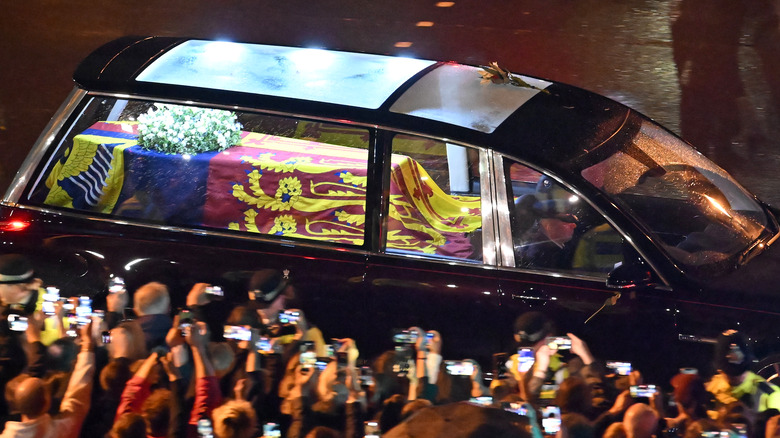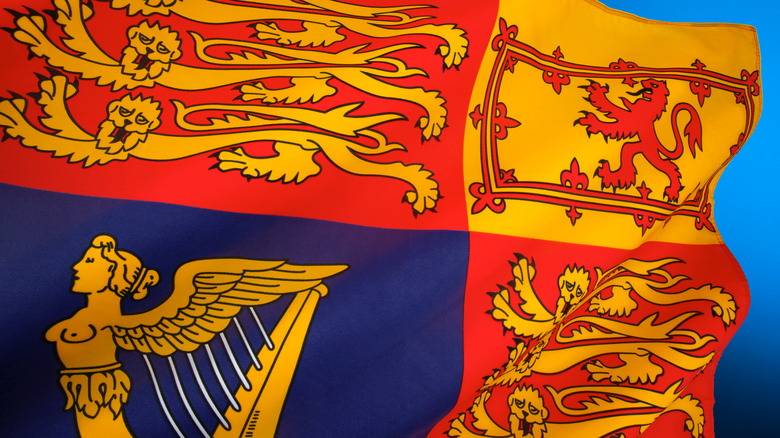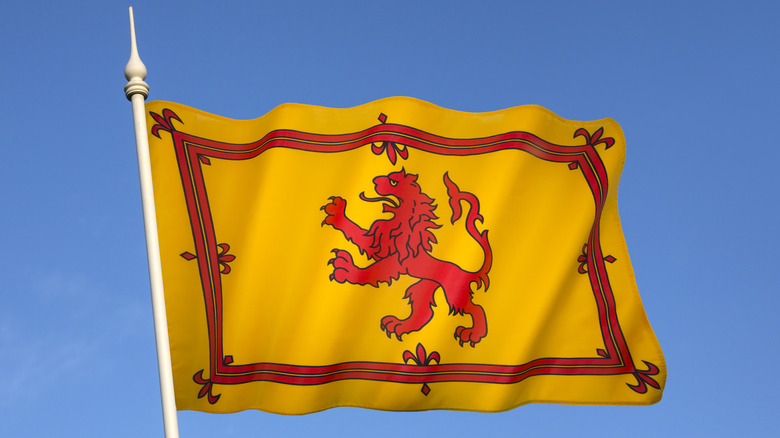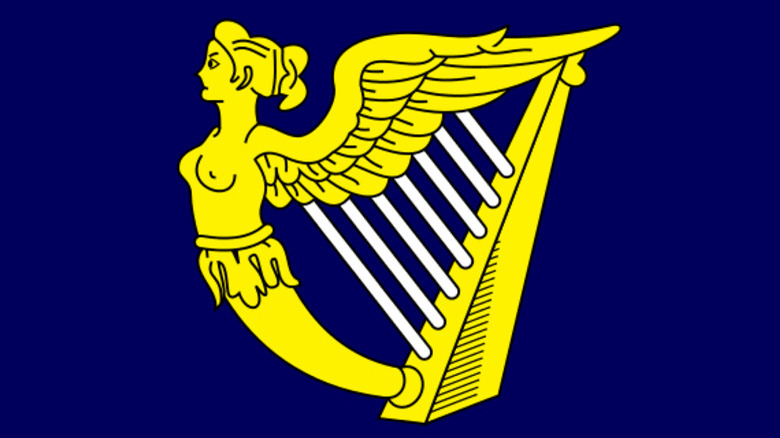Here's What The Flag Draped Over Queen Elizabeth's Coffin Really Means
Queen Elizabeth II, the second longest reigning monarch in history, eclipsed only by the "Sun King," Louis XIV, died on September 8, 2022, at the age of 96. In the days that have followed, the U.K. has entered a prolonged period of public grief, and the world's gaze has been firmly fixed on Britain. Much of the international intrigue into this monumental event has centered on the pomp and ceremony of the late Queen of England's burial rituals.
What has piqued the interest of many in this entire situation is the painstaking preparation for all outcomes that have long preceded the Queen's death. Everything from a 30-year-old coffin, to specific bagpipe funeral music played as the queen's coffin left St. Giles, to the black ties newscasters must wear, to even having remains flown to London via military plane, every step of the way has been meticulously arranged.
As the queen's remains were transported from her royal residence in Balmoral Castle to her eventual final resting place at Windsor Castle, her casket has been photographed a lot recently in the media, draped completely in a colossal flag. The enormous flag placed over the queen's coffin has gotten a lot of attention, but what do the symbols on this flag represent?
The Top Left and Bottom Right Symbols Represent England
Keen observers of British Royal family funeral rituals may have observed that the flag thrown over the late queen's casket resembles somewhat the flag that covered the coffin of her late husband, the former Duke of Edinburgh, Prince Philip, who died in April 2021.
This enormous flag draped over the coffin of Elizabeth II is comprised of quadrants, two of which are identical. This flag is known as the Royal Standard, and it serves as the British monarchy's official banner of arms. Each quarter depicts a distinct constituency ruled over by the queen herself during her lengthy reign (via Royal Family).
As you can see, the top left and bottom right quadrants are always the same. Both of these quadrants feature three golden lions with their right paws raised amidst a backdrop of red. According to The Guardian, these gilded lions are inspired by the ancient folklore from bygone English kings.
The origins of lions as a royal insignia of English royalty may be traced back to William the Conqueror, who initially had only two on his shield in during the mid-11th century, per BBC. Eventually, in the 12th century, Richard the Lionheart would include the third lion into his coat of arms to inspire his warriors on the battlefield (per The Guardian). These mythological golden lions have since remained on the banner of the Royal Family of England for generations.
The Top Right Symbol Represents Scotland
The banner in the top right corner symbolizes the queen's northern principality of Scotland, with a vivid red lion against a backdrop of yellow. This lion has a considerably more ferocious pose, standing upright as if poised to attack. For centuries, this flag was considered Scotland's unofficial flag and served as the royal emblem of the kings and queens of Scotland (per Historic U.K.).
The Windsor dynasty, including the late queen and her successor the current King Charles III, can directly trace their bloodline back to James VI of Scotland. These Scottish ancestors are deeply rooted in their family tree (via National Records of Scotland). So much so that the queen's casket was adorned with the Crown of Scotland for the Giles Cathedral liturgy.
Interestingly, the original Royal Standard draped over the queen's remains during the service at Giles Cathedral was the Scottish Royal Standard, as she died in her Scottish Summer home of Balmoral Castle (via BBC). Instead of the English coat of arms, the Scottish variation of the Royal Standard has two red Scottish lions in the top left and bottom right quadrants and the English coat of arms in the second top right quadrant (per Royal Standard).
The original Royal Standard flag has since been replaced with the original flag displaying the two English golden lion quadrants, as the queen's remains are now lying-in-state at Westminster until her funeral on Monday, September 19th (per Metro).
The Bottom Left Symbol Represents Northern Ireland
Finally, the bottom left emblem, a silver harp on a blue background, depicts the queen's most troubled province, Northern Ireland (per Royal Standard). The harp is a powerful emblem in Irish folklore and the island's national instrument. It can be found on coins, pint glasses, passports, and everything in between.
However, given the tumultuous relationship between the two islands over the last 800 years, the inclusion of the Harp in the Royal Standard to represent Northern Ireland has had its fair share of controversy in the past (to put it mildly). Given that Elizabeth II's namesake, Elizabeth I, famously once decreed that all harps should be burned and all harpers should be hanged during her reign over the island, it's easy to see why some would object to its presence on the official Royal Standard.
Former Irish Free State President, Éamonn DeValera, famously demanded in 1937 that the harp be removed from the Royal Standard since the Irish people of the Republic of Ireland had not given their consent. Unsurprisingly, this plea was not taken seriously as a political problem which obviously fell on deaf ears (via Discover Ireland).
As you can see, the Royal Standard is densely packed with symbolism that is fundamental to the monarchy and its history. By draping the Royal Standard over the queen's coffin for the duration of all commemorations, the nation is using this flag to delicately represent the gravity felt from the loss of their leader.



